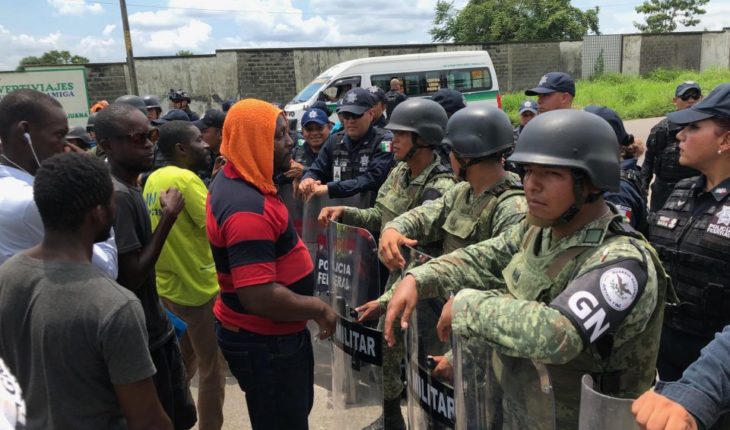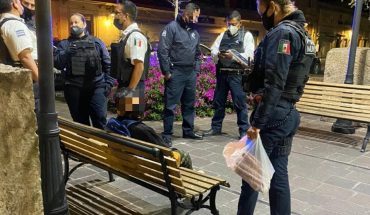“I arrived in Tapachula a month ago. I left Cameroon and went straight to Ecuador. From there to Colombia. I climbed mountains, walked through the jungle, to find this shit. This shit! They don’t feed me. They don’t give me anything. I’m very angry with the government of Mexico. This is not normal. This is bullshit. We need a solution. We just want to get out of here.”
Esteban Azu is 37, Cameroonian and desperate. Your goal is to reach the United States. His journey led him to pass through Turkey, Ecuador, Colombia, Panama, Costa Rica, Nicaragua, Honduras, Guatemala and Mexico. At this time, he says, he spent about $8,000. He claims, in a Spaniard learned in Equatorial Guinea, that he is a plumber and that he could do a good job in the north. But he’s trapped in Tapachula, Chiapas.
Read: National Guard and Federal Police dissolve with shouting African migrant protests in Chiapas
If Azu had arrived in Mexico in February, for example, he would probably already be in Tijuana and had collected his number to process his asylum application in the United States. But everything changes very quickly in immigration policy, especially since Donald Trump initiated the blackmail of tariffs. So Azu is stranded in Tapachula.
On June 7, an agreement was signed with the United States committing to increase pressure on migrants in exchange for Washington’s non-tariff on exports. Since then, the National Guard has been deployed on the southern and northern borders and the detensions and deportations have multiplied. According to data from the Ministry of Foreign Affairs, the flow of migrants decreased by about 40% in July.
Like hundreds of colleagues, Cameroonians arrived in Chiapas and turned himself in to the National Migration Institute (INM). He spent a week locked up in the 21st century and received an exit job. In this he is described as “stateless” despite acknowledging that his nationality is Cameroonian. This occurs because the consulate in your country did not respond to Mexico’s requirements to be recognized. Actually, it’s your guarantee that you won’t be deported. The trade also tells him to regularize his situation. Otherwise, you will have to leave the country on its southern border. There’s the key. “By its southern border”.
Read more: Government sends US-returned asylum seekers to Guatemala border
Previously, migrants in the same situation as Azu received a trade in which they did not determine where they had to leave Mexico. So they used their 20 days to go up north and seek asylum in the United States. If they had money, they could even fly. This led to the mistaken exit ingesses being commonly known as “safe conduct”. This mechanism was used by migrants from all over the world: Cameroonians, Haitians, Cubans, Hindus.
For about two months this has changed.
According to human rights organizations such as Fray Matías or the Jesuit Service to Migrants, citizens of various countries in Africa, Asia or the Caribbean have no options to leave Chiapas since then.
The change has to do with an office aimed at the representative offices of the National Migration Institute (INM), dated July 10 and signed by Ana Laura Martínez de Lara, former Director General of Migration Control and Verification. It is included in an amparo prepared by the activist Luis Villagrán and which will be presented on Monday. Animal Político confirmed its authenticity through Martínez de Lara herself.
It is a document with instructions on the exit office “for regularization purposes”. It states that it “does not grant a condition of stay”, but the possibility of legalizing your situation if it complies with the law. In addition, it specifies that “with this document foreign persons cannot freely transit through national territory”.
Finally, it includes the rules for leaving the country.
“In accordance with Section IX of Article 240 of the Regulations of the Migration Act, the foreign person who obtains this benefit and does not submit the corresponding procedure within the period indicated to him, shall leave national territory within the same timeframe through a place for the international transit of persons on the southern border closest to the place where the document was issued,” he says. This reference to the southern border appears in the exit offices that migrants like Esteban Azu have been receiving in recent weeks.
The problem is that Section IX of Article 240 of that regulation does not say that.
What the legislation says is that “in the event that the foreign person does not submit the corresponding procedure in the period indicated to him, he must leave national territory within that period”. In other words, there is no reference to the place where the foreigner should leave the country. This point was also not included in the exit offices given to foreigners in previous years. They were only told that if they did not show up to the INM delegation in 20 days, they should leave the country. Exactly what they wanted. Leaving Mexico across the northern border.
You may be interested: From Qatar to Veracruz, the 65 Asian migrant scan that will end in deportation
Animal Político consulted the INM on this modification, but sources at the institute declined to comment. Ana Laura Martínez de Lara was also asked, who noted that it was in line with previous orders and that its objective was to encourage the regularization of foreigners. According to him, there was no pressure to make this modification.
Today, dozens of migrants, mostly Africans, sleep outside the 21st century migrant station. They find themselves trapped without work, without prospects for the future and without knowing the language. They report that the change in the exit office prevents them from continuing their transit north, as other colleagues did before them. Political Animal spoke to five of these migrants, three of them from Cameroon, one from Angola and one from the Democratic Republic of the Congo.
They all agreed on the same story. They claim that, after leaving the immigration station, they were ordered to go to the regularization office known as Las Vegas. They claim that they submitted their documentation but have not received a response. Times vary between month and three weeks and two weeks of waiting.
The options they are offered are two, they say: regularize before the INM or seek asylum at the Mexican Commission for Refugee Assistance (Comar). The first option is unfeasible because, they claim, no one has received any kind of documentation that allows them to transit through Mexico. The second one is rejected. They don’t want to apply for shelter in Chiapas because they want to do it in the United States.
Read more: From humanitarian discourse to soldiers at the border, the turn in government migration policy
Between January and June, 3,712 people from Africa were presented to the INS. Cameroon is the majority country, with 1,602 migrants, followed by the Democratic Republic of the Congo.
In the same period, only 46 visitor cards were delivered for humanitarian reasons. Of these, only five were Cameroonians.
Only two African citizens were deported throughout this period, according to INM data: one to Ivory Coast and one to Lesotho.
“We’re trapped,” Azu says. He says he has no intention of backtracking.
And what was Esteban Azu going to do in Guatemala? What could you do in the country where six out of ten are poor, where, since January, more than 200,000 people have been detained at the U.S. border trying to cross like him?
“It’s illegal. They changed that word to force him to go across the nearest border. The other exit offices established, establish, because this is the law, that they have 20 days to leave through any of the borders,” says Luis Villagrán, lawyer and director of the Center for Human Dignification. He claims to have gathered 800 signatures for an amparo that he says he will present on Monday. It’ll be a federal judge who decides.
Meanwhile, conditions abroad in the 21st century are worsening every day. More tents have been progressively installed. Dozens of people sleep there, in front of the migratory station, almost out in the open. They feel abandoned, humiliated, forgotten, discriminated against. They demonstrated by cutting the access road to the detention centre and were beaten. And their situation remains exactly the same: with no prospect of moving forward.
“Humanitarian conditions are very serious. Every day they are getting worse,” Claudia León of the Jesuit Service to Migrants. Remember that there have been cases of people convulsing, exhausted, for lack of food and water. “Are you waiting for someone to die?” he asks.
What we do in Animal Político requires professional journalists, teamwork, dialogue with readers and something very important: independence. You can help us keep going. Be part of the team.
Subscribe to Animal Politician, receive benefits and support free journalism.#YoSoyAnimal





